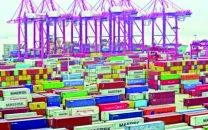STPF 2015-18 : Focus needs to be on ‘efficiency-driven’ economy
Country must enhance linkages between firms, research institutes to increase exports, rank high on ECI

Country must enhance linkages between firms, research institutes to increase exports, rank high on ECI. PHOTO: REUTERS
The Ministry of Commerce recently announced the Strategic Trade Policy Framework 2015-2018 (STPF 2015-2018).
Although considerably delayed, the document provides a direction to the policymakers to enhance exports from Pakistan.
The statistics on exports, however, do not paint a promising picture.
Considering the data borrowed from the International Trade Centre, the annual growth in global exports from Pakistan between 2010 and 2014 is reported at 3%, lower than the growth in total global exports reported at 5% for the same period.

This indicates that the share in global exports, albeit negligible, will deteriorate further.
STPF 2015-2018 aims to reach $35 billion by 2018 from approximately $25 billion in 2014 and seeks a transition from a ‘factor-driven’ economy to an ‘efficiency-driven’ and ‘innovation-driven’ economy.
A major concern on the composition of the products exported from Pakistan is that they lack sophistication, which exposes them to intense competition from producers around the world, and lack diversification as the number of products is limited. This lack of complexity is an indicator of a ‘factor-driven’ economy, as raw materials needed to produce subsequent products domestically are often exported.
In 2014, Pakistan was ranked 90th out of 124 countries on the economic complexity index as measured by the Atlas of Economic Complexity (developed by the Centre for International Development at Harvard University).
A country is ranked high on complexity if it not only exports a range of more sophisticated products, such as chemicals, machinery and electronic equipment, but also a greater number of products. Economic complexity is the measure of productive knowledge that a country possesses through its individuals and organisations.
The capability to combine knowledge, through effective research and product development methods, will create sophisticated products and produce a wider range of products for their export markets.
The policymakers need to emphasise on enhancing linkages between firms, domestic as well as foreign, government organisations, and research institutes to create complex products. Such enhancements will benefit firms as it may not only increase their sales in destination markets but also shield them from other competitors.
As STPF 2015-2018 focuses on export-oriented firms, its implementation should be based on a classification of firms in terms of their exporting activities: (i) never exporters or firms that do not intend to export their products, (ii) firms that are interested in exporting in the near future, (iii) new exporters or emerging exporters, who export but are yet to develop their presence in the export markets, (iv) experienced or mature exporters who have exported a given value consistently for a given number of years and (v) firms that have previously exported but have discontinued in the recent years.
This classification of exporters is similar to that recommended by a USAID-funded project titled ‘Best Practices in Export Promotion.’ Production linkages between firms within and across each classification must be promoted. Firms in ‘factor-driven’ economies produce in isolation from other firms but firms in ‘efficiency-driven’ economies and ‘innovation-driven’ economies must rely on other firms through production linkages, where pooling of knowledge between firms becomes a necessity.
Export incentives should be provided such that there is a desire for firms to increase the complexity of the products that are exported, particularly through production linkages.
Exporting activities entail significant costs to sell products in a foreign market, such as fixed costs to brand, distribute and service their products in their destination markets.
It may also entail risks related to volatility in exchange rates between currencies and the quality of information on the destination market. The pooling of knowledge between firms across different classifications of exporters may allow them to reduce the risks associated with exports as only the most effective and innovative production techniques are adopted by exporting firms.
With the help of well-targeted export promotion programmes that create production linkages based on efficiency and innovation, Pakistan can achieve a higher ranking on the economic complexity index and enhance its exports.
A successful trade promotion strategy that complements the most complex products must create awareness of the benefits, costs and risks associated with exporting and entering newer markets, improve the ability to export of firms through knowledge on the most efficient inputs and technological innovations, and provide opportunities to meet potential buyers through regular trade fairs and exhibitions. Finally, the most competent trade officers must be posted in the most important destination markets.
Unfortunately, the STPF 2012-2015 was not successfully implemented. Only a committed effort by all the stakeholders will prevent STPF 2015-2018 from collapsing to the same fate. It is in our national interest to convert the ambitions set forward in the STPF 2015-2018 into a reality.
The writer is an Assistant Professor of Economics & Research Fellow at CBER, IBA
Published in The Express Tribune, April 18th, 2016.
Like Business on Facebook, follow @TribuneBiz on Twitter to stay informed and join in the conversation.


















COMMENTS
Comments are moderated and generally will be posted if they are on-topic and not abusive.
For more information, please see our Comments FAQ